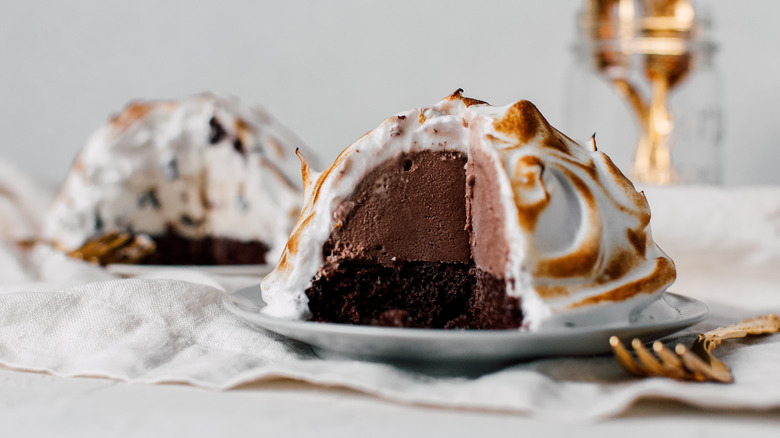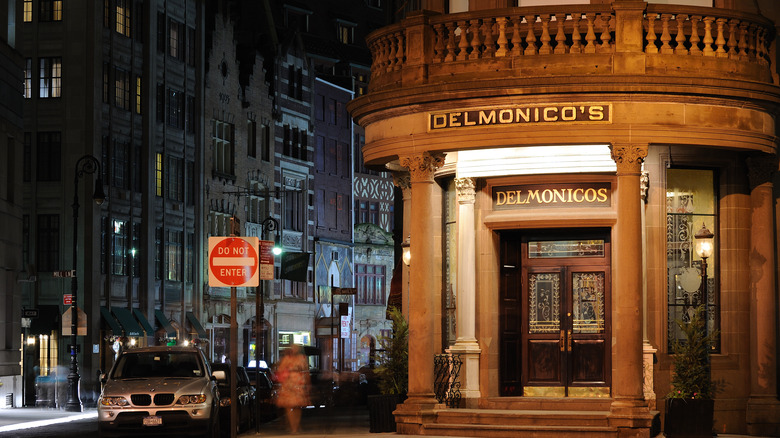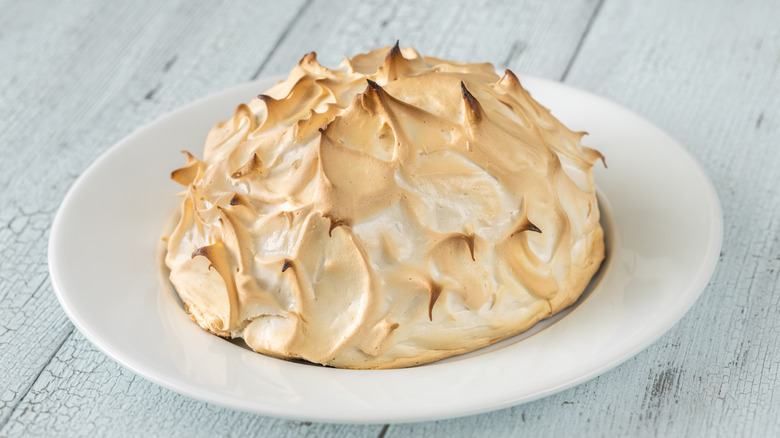Baked Alaska Wasn't Invented In Alaska, So Where Does It Come From?
There's no shortage of foods with misleading names, but there's at least one dessert that's basically lying to your face: Baked Alaska. This marvelous, quirky, and vintage combination of cake, meringue, and ice cream has almost no connection to the 49th state — and just to rule it out from the get-go, the name doesn't have anything to do with the dessert's white, mountainous shape that could almost resemble a mountainous Alaskan landscape set ablaze (if you squint).
Perhaps the most widely accepted origin story for Baked Alaska (sometimes called Bombe Alaska) is that it surfaced at famed NYC fine dining restaurant Delmonico's. Prominent chef Charles Ranhofer reportedly first served it in 1867, albeit with slight differences (such as the addition of marmalade) compared to modern-day Baked Alaska. It also had a different name: "Alaska, Florida," referring to the disparity between the cold ice cream (Alaska), and the hot flambéed meringue (Florida). The "Alaska" part of the name is rumored to be a reference to the United States' purchase of Alaska in 1867 (and was possibly Ranhofer making fun of this political move), although there's little concrete evidence to back this up. In any case, the "Alaska, Florida" name stuck until at least the 1890s, when it appeared in Ranhofer's 1893 cookbook "The Epicurean"; a recipe for "Baked Alaska" also appears in chef Fannie Farmer's "The Boston Cooking-School Cook Book" from 1896, although the reason for the name remains murky.
Baked Alaska's precursors
The Baked Alaska (or Alaska, Florida) from Delmonico's didn't materialize out of nowhere — it's generally accepted that a kindred dessert was created in France with the name "Omelette Norvégienne" ("Norwegian omelet" in English). This name is still used in French, and in its modern form, it's pretty much the same as a Baked Alaska: A simple cake coated with vanilla ice cream and topped with brûléed meringue. (Of course, there are variations that use different flavors for the cake or ice cream.)
However, the French took that idea from an American scientist, Benjamin Thompson, who later adopted the name Count Rumford. He discovered that egg whites offered great insulation against heat, meaning that ice cream covered by a meringue (made with egg whites) wouldn't melt, even if you blow-torched the meringue. Thompson created a dish called "Omelette Surprise," which in turn was adopted in France. According to NPR, who spoke with former Delmonico's executive chef Billy Oliva, Ranhofer likely adapted this — his version was more extravagant than the plainer Omelette Norvégienne, as it featured a spiced walnut cake and banana ice cream. It had a price tag to match these then-expensive ingredients: In present-day terms, a portion of Alaska, Florida from Delmonico's would be around $52.
Other theories about Baked Alaska's history
A lot of the history around Baked Alaska is hazy — for example, Michael Krondl, a historian who helped edit "The Oxford Companion to Sugar and Sweets," told NPR that the Omelette Norvégienne (and by extension, Baked Alaska) didn't appear until the 1890s; some other evidence points to the 1880s, although the fact that it appeared in Ranhofer's cookbook in 1893 is indisputable. There are also indications that a pie-like dish with ice cream also existed in the 1850s, but with Chinese origins, though with more of a pie crust, it's not particularly similar.
However, one of the more notable theories about Baked Alaska suggests it was invented in an entirely different place: New Orleans. This story also places the dessert's creation around 1867, and with the name Baked Alaska (again, referencing the American purchase of the territory). Specifically, chef Antoine Alciatore of famed Creole restaurant Antoine's has been credited with creating the dessert (or at least, a version of it). While it's still a staple of the menu at that French Quarter restaurant, it's notable that the restaurant doesn't openly claim to have invented it, and the Delmonico's story is generally thought to have more corroborating evidence. That said, considering the prior existence of the Omelette Norvégienne, it's possible Alciatore drew inspiration from the French predecessor and created a very similar dish at the same time as Ranhofer, but there's no clear information to back this up.


